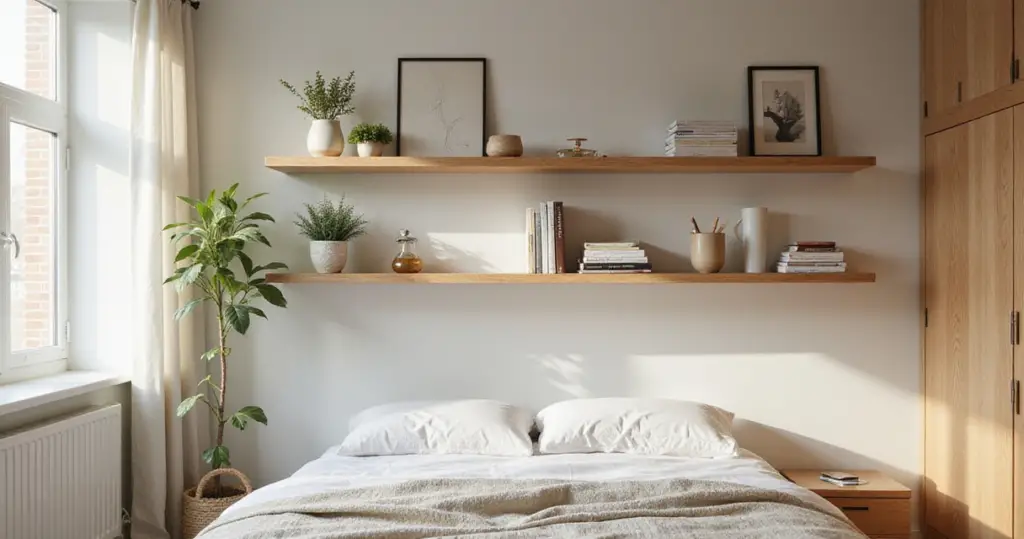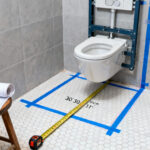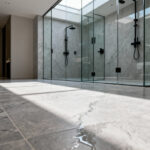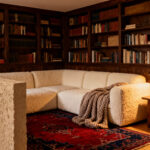Creating a functional and beautiful bedroom in a small apartment requires more than just good intentions—it demands strategic thinking about every square inch. When you’re working with limited space, your bedroom needs to serve multiple roles: a peaceful retreat for rest, an organized storage hub, and a reflection of your personal style. The challenge isn’t just fitting everything in; it’s making the space feel expansive, intentional, and genuinely comfortable.
The modern apartment bedroom faces unique constraints that previous generations didn’t encounter. With average apartment sizes shrinking and urban living costs rising, maximizing every corner becomes essential. Yet these limitations spark incredible creativity. The most successful small bedroom designs don’t just accommodate—they transform constraints into advantages, turning compact quarters into highly efficient, surprisingly spacious sanctuaries.
These 21 carefully curated apartment bedroom ideas will help you navigate common challenges like inadequate storage, poor lighting, and cramped layouts. From clever furniture choices that serve double duty to visual tricks that expand perceived space, each strategy addresses real problems with practical solutions. Whether you’re a first-time renter or a seasoned apartment dweller, these ideas will help you create a bedroom that feels both larger and more luxurious than its square footage suggests.
1. Maximize Vertical Space with Wall-Mounted Shelving
Wall-mounted shelving transforms neglected vertical space into valuable storage real estate, instantly making your bedroom feel more organized and spacious. By lifting books, decor, and personal items off surfaces and floors, you create clean lines that trick the eye into perceiving more space. This approach can reclaim 15-20 square feet of usable floor area while increasing storage capacity by up to 50% without demanding any additional footprint.
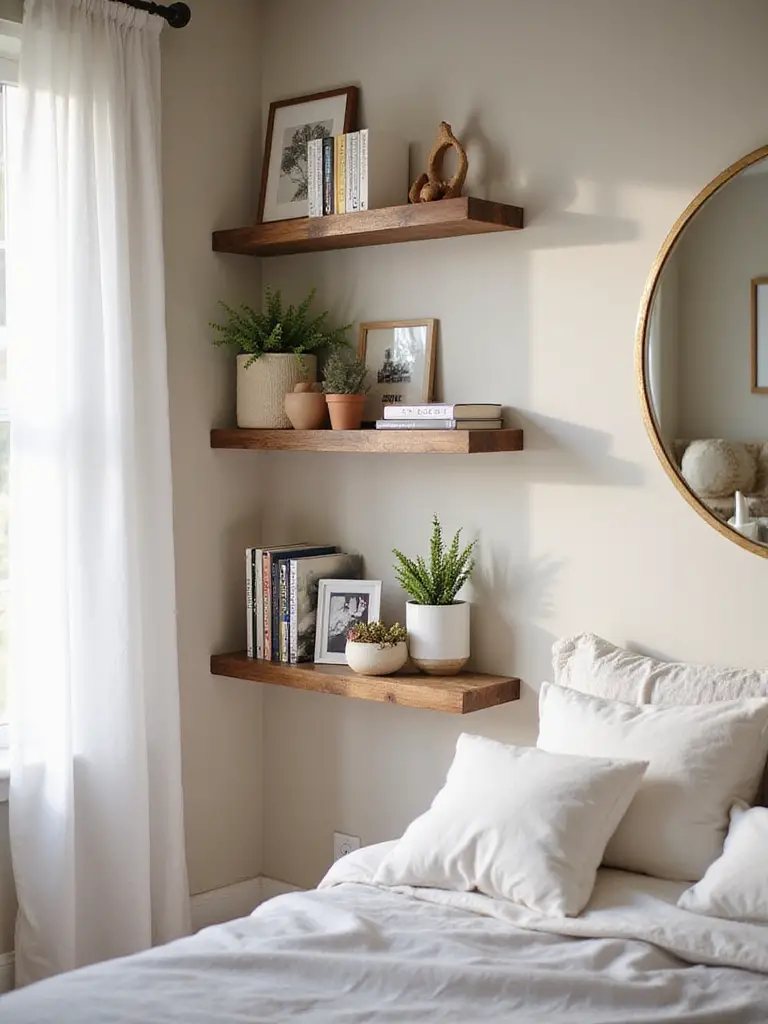
The psychological impact extends beyond mere functionality. Floating shelves create an illusion of airiness by keeping floors clear, while strategic placement can draw the eye upward, making ceilings appear higher. Professional organizers consistently recommend this “vertical thinking” approach for small spaces, as it addresses both storage needs and spatial perception simultaneously.
Key considerations for wall-mounted shelving:
- Measure carefully and locate wall studs for secure installation
- Choose materials that complement your existing decor
- Plan for appropriate weight distribution across multiple shelves
- Consider integrated lighting to highlight displayed items
What makes this collection special is the way each shelf becomes both functional storage and decorative display, creating visual interest while solving practical problems.
2. Choose Multi-Functional Furniture for Dual Purpose
Multi-functional furniture represents the cornerstone of intelligent apartment bedroom ideas, allowing every piece to earn its place through multiple uses. A storage ottoman serves as seating, a footrest, and a place to stash extra linens. A Bed Frame with built-in drawers eliminates the need for a separate dresser. These strategic choices can reduce furnishing costs by 20-40% while dramatically improving space efficiency.
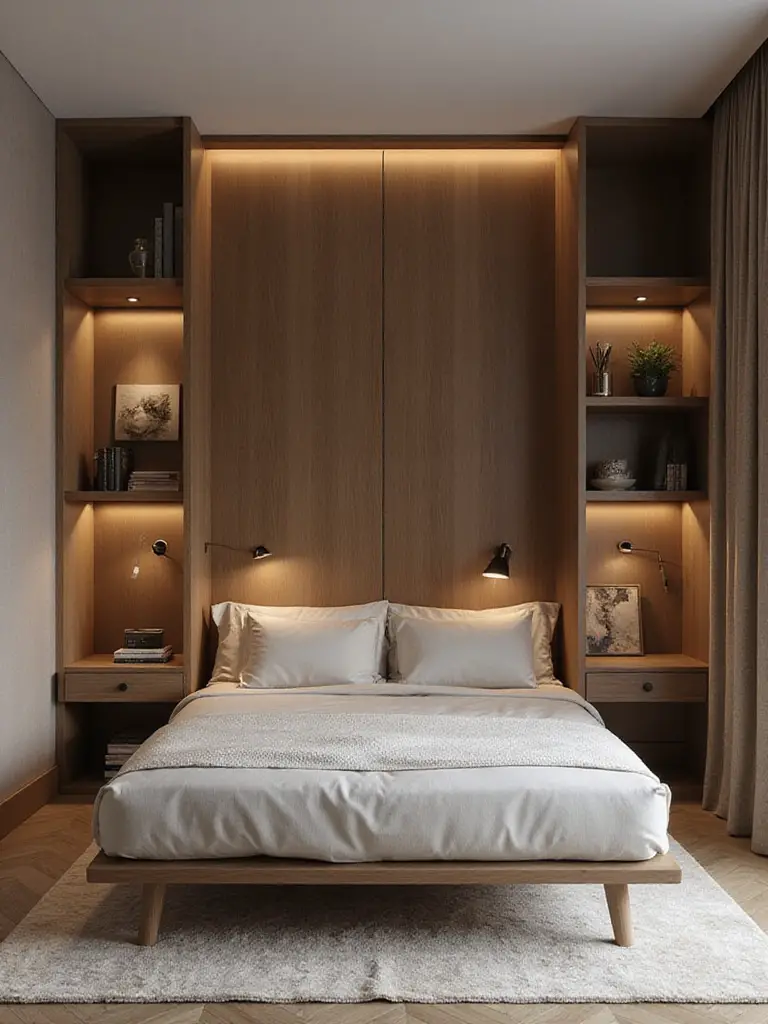
The key lies in prioritizing pieces where both functions serve genuine needs rather than forcing functionality for its own sake. A desk that folds into a nightstand works beautifully if you actually work from your bedroom, but becomes cumbersome if you rarely need workspace. Quality mechanisms matter significantly—invest in sturdy hardware for items like Murphy beds or expandable tables to ensure longevity and ease of use.
Essential multi-functional pieces to consider:
- Storage beds with built-in drawers or lift-up mattresses
- Nesting tables that tuck away when not needed
- Folding desks that double as vanities
- Benches with hidden storage compartments
The interplay between the colors creates a cohesive look while each piece adapts to your changing daily needs throughout the seasons.
3. Invest in a Quality Mattress for Superior Sleep
While not immediately obvious as a space-saving strategy, a quality mattress maximizes the value of your bedroom’s most important square footage. In compact living situations, your bed serves as the primary recovery zone, making sleep quality crucial for overall well-being. A superior mattress can reduce back pain by up to 60% and improve sleep quality by 15-25%, directly impacting your daily productivity and mood.
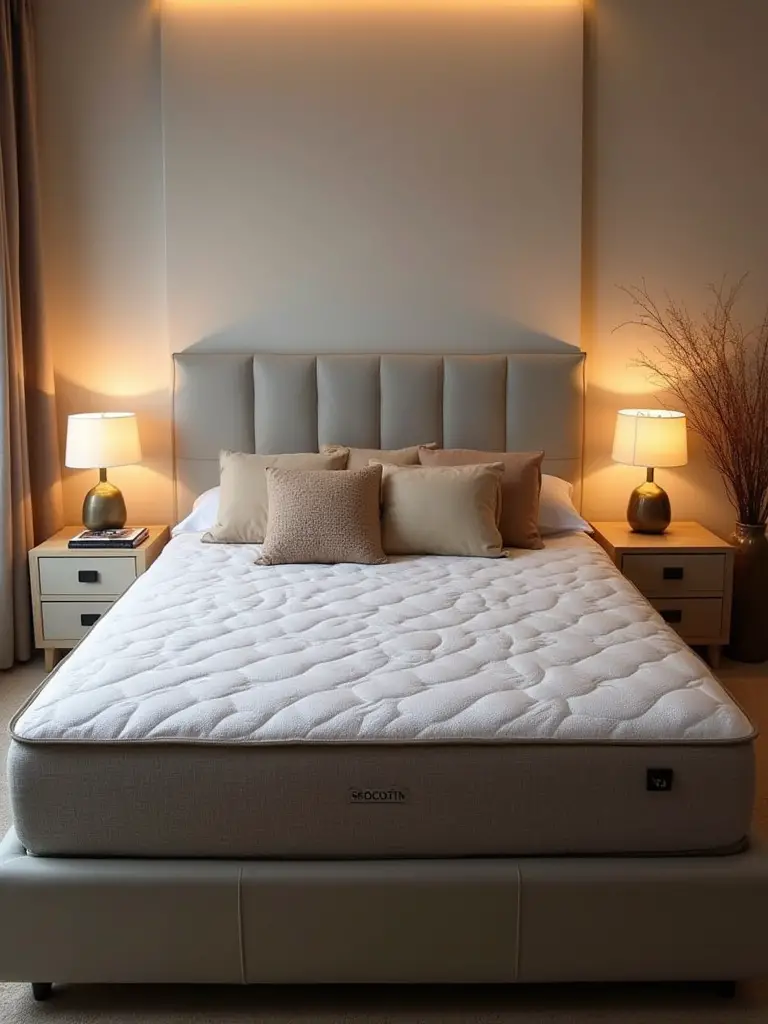
Modern “bed-in-a-box” options solve logistical challenges common in apartment living, compressing for easy transport through narrow hallways and up stairs. These innovative designs often incorporate advanced materials like memory foam or hybrid constructions that provide excellent support without requiring traditional box springs, saving valuable vertical space.
Mattress selection criteria for apartments:
- Consider weight and ease of moving for future relocations
- Prioritize temperature regulation for smaller, potentially warmer spaces
- Look for certifications like CertiPUR-US for air quality safety
- Utilize trial periods to test comfort in your specific environment
The sustainable journey of this material involves careful consideration of your sleep patterns and physical needs, ensuring your investment enhances rather than compromises your rest.
4. Optimize Layout with Strategic Bed Placement
Strategic bed placement serves as the foundation for all other apartment bedroom ideas, as this largest piece of furniture dictates the entire room’s flow and functionality. Proper positioning can increase usable floor space by up to 25% while improving navigation and natural light access. The bed’s location influences everything from morning routines to evening relaxation, making thoughtful placement essential for daily comfort.
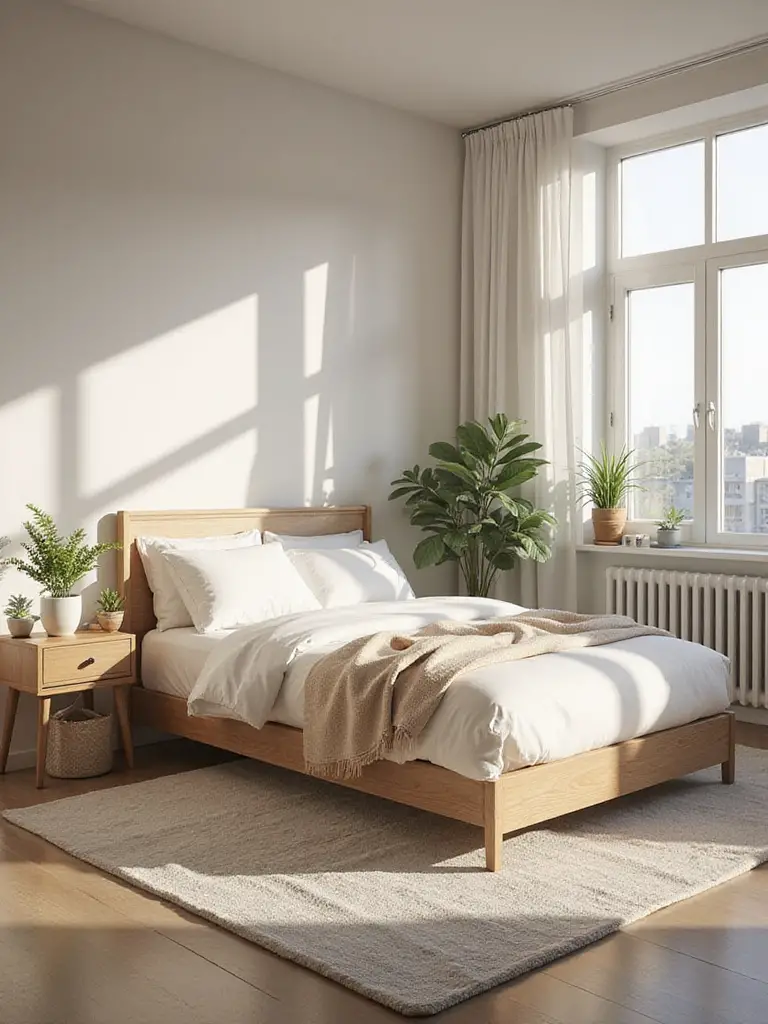
Consider unconventional orientations that maximize your specific room’s assets. Placing a bed diagonally in a corner can create surprising amounts of usable space, while positioning it away from walls (even by just a few inches) can make the room feel less cramped and improve air circulation. The goal is creating clear pathways while establishing the bed as an intentional focal point rather than an obstacle.
Strategic placement principles:
- Ensure clear access to closets and bathroom doors
- Position to take advantage of natural light without blocking windows
- Consider views from the bed for both rest and daily activities
- Plan for electrical outlet access for bedside lighting and charging
The artisan collective that creates these pieces understands how spatial relationships affect daily living, designing layouts that feel both functional and harmonious.
5. Enhance Ambiance with Layered Lighting Solutions
Layered lighting transforms apartment bedrooms from simple sleeping spaces into versatile, mood-responsive environments. By combining ambient, task, and accent lighting, you create depth and flexibility that makes small rooms feel larger and more sophisticated. This approach allows seamless transitions from bright morning energy to cozy evening relaxation, maximizing the utility of your limited square footage.

The biggest mistake in small bedrooms is relying on a single overhead fixture, which creates harsh shadows and flattens the space. Instead, distribute light sources at different levels—table lamps for reading, wall sconces for ambient glow, and perhaps LED strips for accent lighting. Smart bulbs add another layer of control, allowing you to adjust color temperature and brightness throughout the day to support natural circadian rhythms.
Essential lighting layers for small bedrooms:
- Dimmable overhead fixture for general illumination
- Bedside lamps positioned to avoid glare while reading
- Accent lighting to highlight artwork or architectural features
- Natural light management through appropriate window treatments
The unexpected pairing that always works is combining warm task lighting with cool accent lighting, creating visual interest while maintaining comfort for various activities.
6. Utilize Under-Bed Storage Bins for Hidden Clutter
Under-bed storage represents one of the most underutilized spaces in apartment bedroom ideas, offering up to 20 cubic feet of hidden storage without sacrificing any floor area. This strategy proves particularly valuable for seasonal items, extra bedding, or belongings you need accessible but not visible. Quality storage bins with wheels and secure lids protect contents while making retrieval effortless.
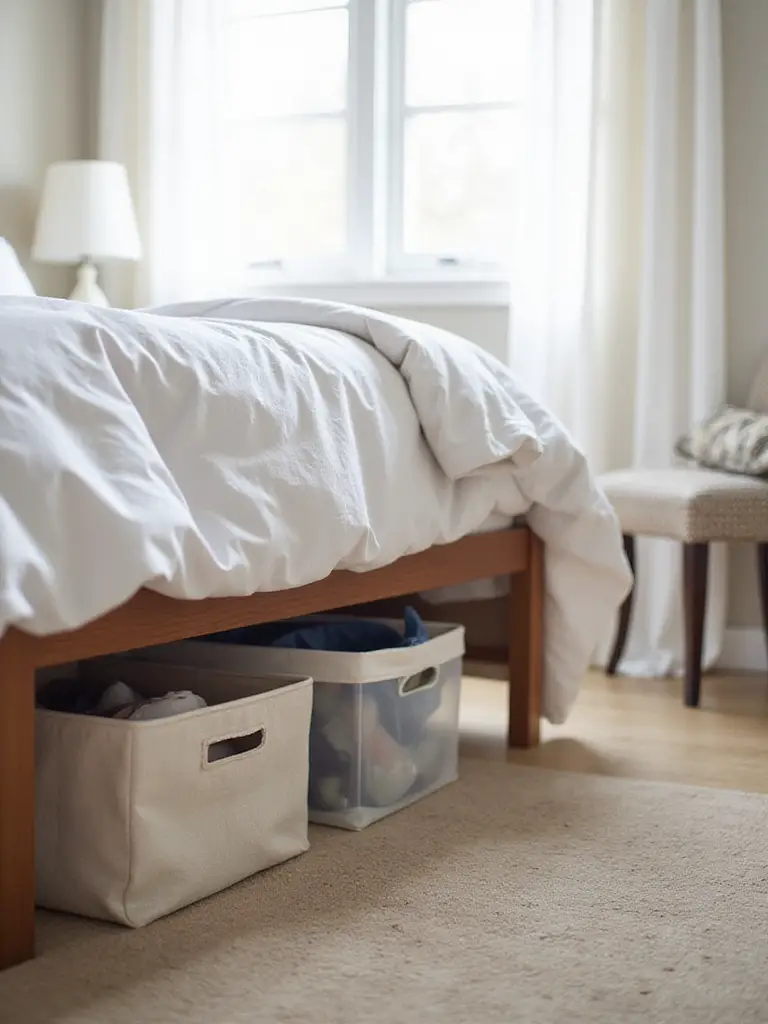
The key to successful under-bed storage lies in organization and accessibility. Vacuum-seal bags can compress bulky items like comforters by up to 80%, maximizing space efficiency. Clear containers allow easy identification of contents, while dividers within bins prevent smaller items from becoming jumbled. Consider the height clearance under your bed frame when selecting storage solutions to ensure smooth operation.
Under-bed storage best practices:
- Measure clearance height before purchasing containers
- Use vacuum-seal bags for soft goods to maximize space
- Label containers clearly for easy identification
- Choose bins with wheels for easy access to items stored toward the back
The environmental story behind this piece began with recognizing that hidden storage reduces visual clutter while maintaining easy access to necessary items.
7. Integrate Smart Closet Organizers for Efficient Storage
Smart closet organizers can increase storage capacity by up to 50% through vertical maximization and efficient compartmentalization. These systems transform chaotic closet spaces into highly organized zones where every item has a designated place. Modular designs adapt to changing needs and different clothing types, making them ideal for apartment living where flexibility matters.
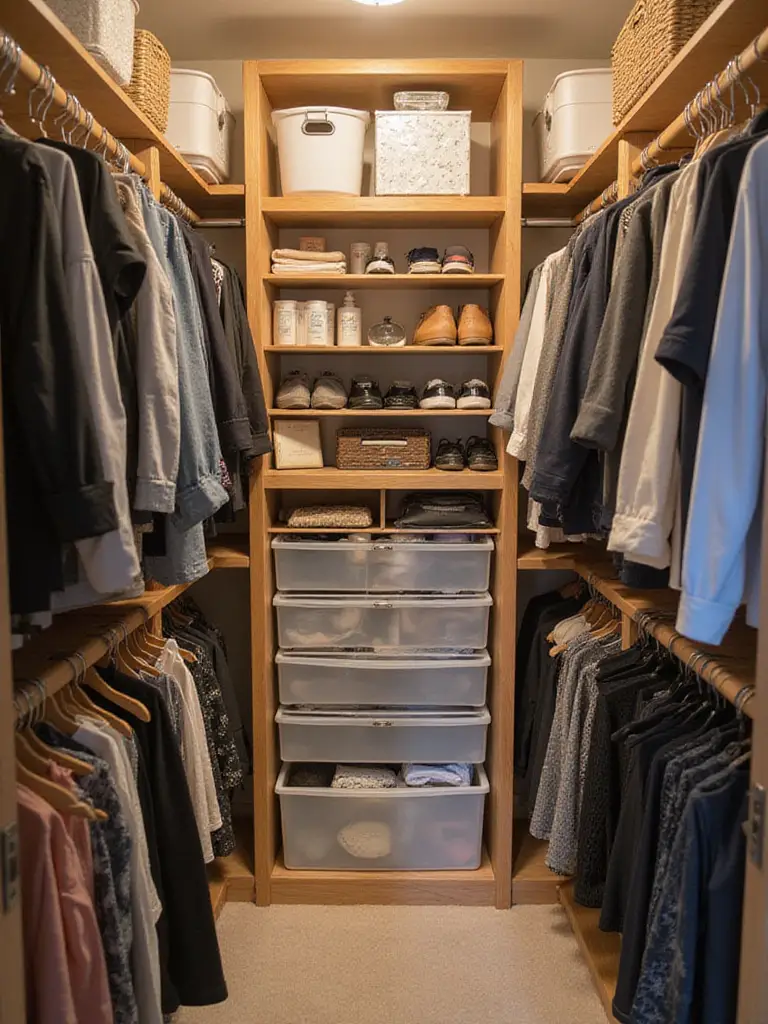
The most effective closet organization begins with ruthless decluttering—organizing only what you truly need and use regularly. Adjustable shelving systems, slim velvet hangers, and drawer dividers create designated homes for different clothing categories. Vertical space utilization through double-hang rods or cascading hangers can effectively double hanging capacity in most closets.
Smart closet organization elements:
- Adjustable shelving systems that grow with your needs
- Slim, non-slip hangers to maximize hanging space
- Clear storage bins for seasonal or occasional items
- Drawer dividers for small accessories and undergarments
What makes this design special is the way it transforms a potentially frustrating daily experience into an efficient, even pleasant routine.
8. Add a Slim Dresser to Maximize Vertical Storage
Slim dressers exemplify the “think vertical” principle essential to successful apartment bedroom ideas, providing substantial storage in a narrow footprint. These tall, narrow units can free up 15-25% more floor space compared to traditional wide dressers while often offering comparable or greater storage capacity. The vertical orientation draws the eye upward, creating an illusion of height that makes rooms feel more spacious.
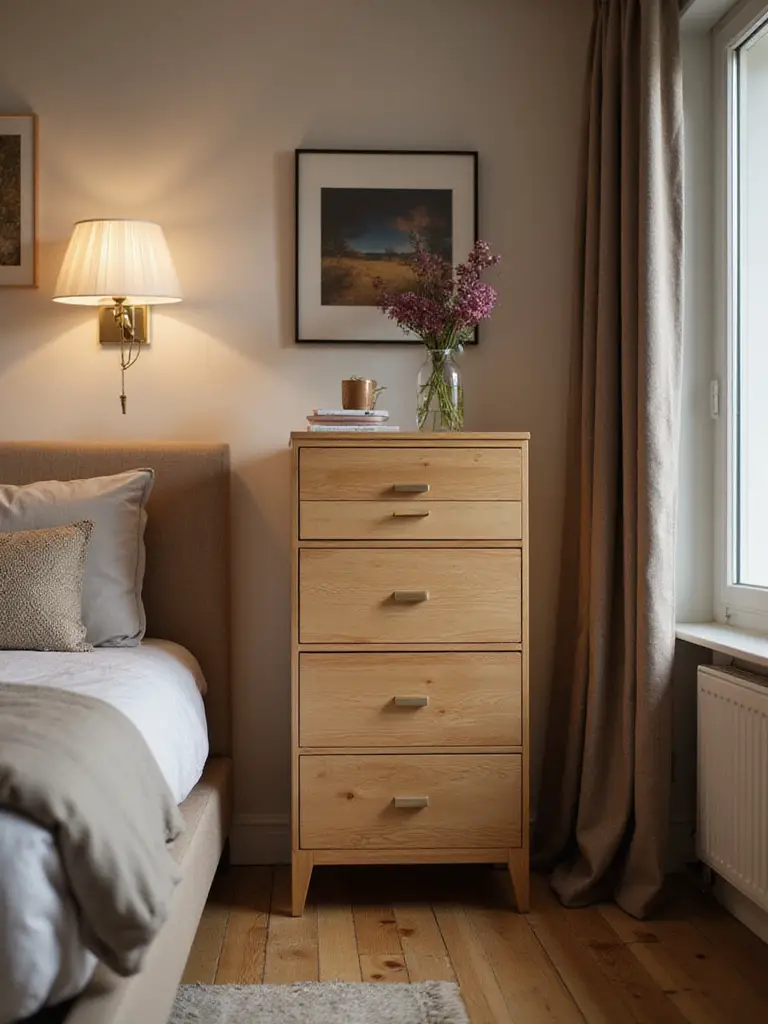
When selecting a slim dresser, prioritize depth and drawer configuration over width. Deeper drawers accommodate folded clothing more efficiently, while varied drawer heights serve different storage needs—shallow drawers for accessories, deeper ones for bulkier items. Safety considerations become crucial with taller furniture; always anchor slim dressers to the wall using anti-tip hardware to prevent accidents.
Slim dresser selection criteria:
- Measure available wall space including height clearance
- Consider drawer depth for efficient clothing storage
- Ensure stability and use anti-tip hardware for safety
- Choose finishes that complement existing bedroom furniture
The craftsmanship reveals itself in details like smooth drawer operation and sturdy construction that withstands daily use while maintaining its elegant proportions.
9. Define Zones with a Stylish Area Rug
Area rugs serve as powerful tools for creating distinct zones within apartment bedrooms, making single spaces feel more organized and purposeful. A well-chosen rug can visually separate sleeping areas from workspaces or reading nooks, creating the illusion of multiple rooms within one space. This psychological division makes small bedrooms feel larger and more sophisticated while providing acoustic benefits that reduce noise and echo.

The size and placement of your rug significantly impact its effectiveness. For bedrooms, the rug should extend at least 18-24 inches beyond the sides and foot of the bed, creating a cohesive sleeping zone. Avoid the common mistake of choosing undersized rugs, which can make spaces feel fragmented and smaller. The rug’s texture and pattern should complement your overall design while adding visual interest without overwhelming the space.
Area rug placement guidelines:
- Extend beyond furniture edges to create cohesive zones
- Choose appropriate size for your specific room dimensions
- Consider texture and pattern impact on overall design
- Use rug pads for safety and extended lifespan
The visual weight balances perfectly when you select a rug that anchors your furniture arrangement while adding warmth and definition to your carefully curated space.
10. Personalize Walls with Removable Peel-and-Stick Wallpaper
Removable wallpaper revolutionizes apartment bedroom ideas by allowing dramatic style changes without permanent commitment or wall damage. This innovation enables renters to create custom, high-end aesthetics that can increase perceived room value by 10-15% while preserving security deposits. The ease of application and removal makes it perfect for those who enjoy refreshing their decor seasonally or as their style evolves.
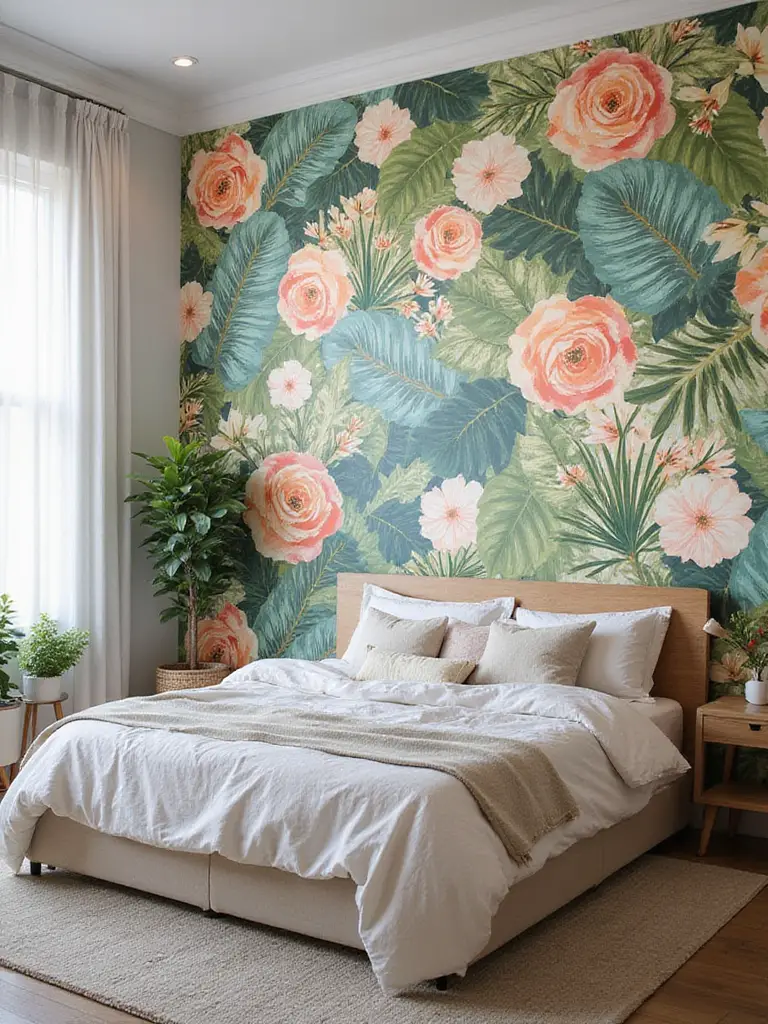
Proper surface preparation ensures successful application and clean removal. Walls must be clean, dry, and smooth, with newly painted surfaces requiring 3-4 weeks to cure before application. Measuring and cutting panels accurately, with slight overlaps between pieces, creates professional-looking results. The key is working slowly and smoothing out air bubbles as you apply each section.
Peel-and-stick wallpaper application tips:
- Clean walls thoroughly with mild soap and allow complete drying
- Measure twice and cut once for accurate panel sizing
- Apply gradually, smoothing from center outward to prevent bubbles
- Use sharp utility knives for clean, precise trimming
The heritage technique gets a contemporary update through modern adhesive technology that allows bold pattern experimentation without long-term commitment.
11. Introduce Greenery with Low-Maintenance Indoor Plants
Low-maintenance indoor plants enhance apartment bedroom ideas by improving air quality, reducing stress, and adding natural beauty without demanding extensive care. Plants like Snake Plants, ZZ Plants, and Pothos thrive in various light conditions while filtering common indoor pollutants. Studies show that indoor greenery can reduce stress levels by 15-20% and improve air quality by up to 25%, contributing to better sleep and overall well-being.
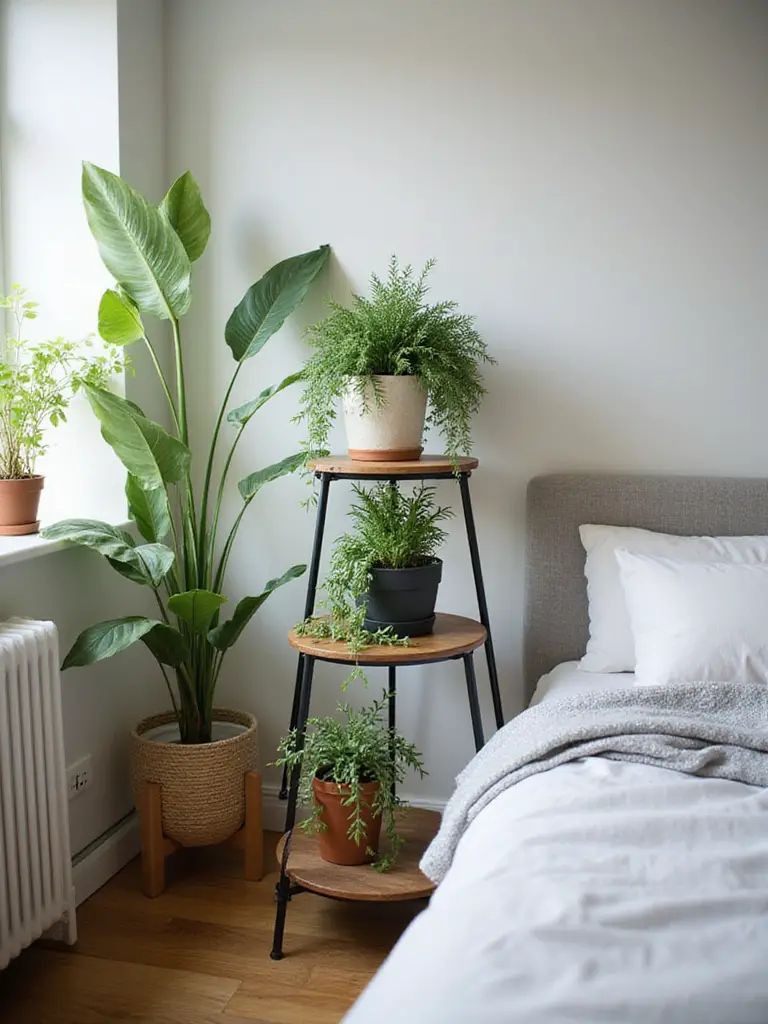
Strategic placement maximizes impact while conserving floor space. Hanging planters, wall-mounted shelves, and tall plant stands utilize vertical space effectively. Consider the specific light requirements of your chosen plants and position them accordingly—most low-maintenance varieties prefer indirect light, making them perfect for bedroom environments where harsh sunlight isn’t desirable.
Best low-maintenance plants for bedrooms:
- Snake Plants (Sansevieria) for low light tolerance
- ZZ Plants (Zamioculcas zamiifolia) for drought resistance
- Pothos for trailing growth and air purification
- Spider Plants for easy propagation and adaptability
The unexpected environmental benefit comes from these plants’ ability to continue producing oxygen at night, unlike most plants that only photosynthesize during daylight hours.
12. Curate a Gallery Wall Using Damage-Free Command Strips
Gallery walls created with Command Strips offer apartment dwellers the opportunity to display personal art and photographs without risking wall damage or security deposits. This approach allows for creative expression and personalization while maintaining the flexibility to rearrange or remove pieces as desired. The key to success lies in planning the layout carefully before applying any adhesive strips to the wall.
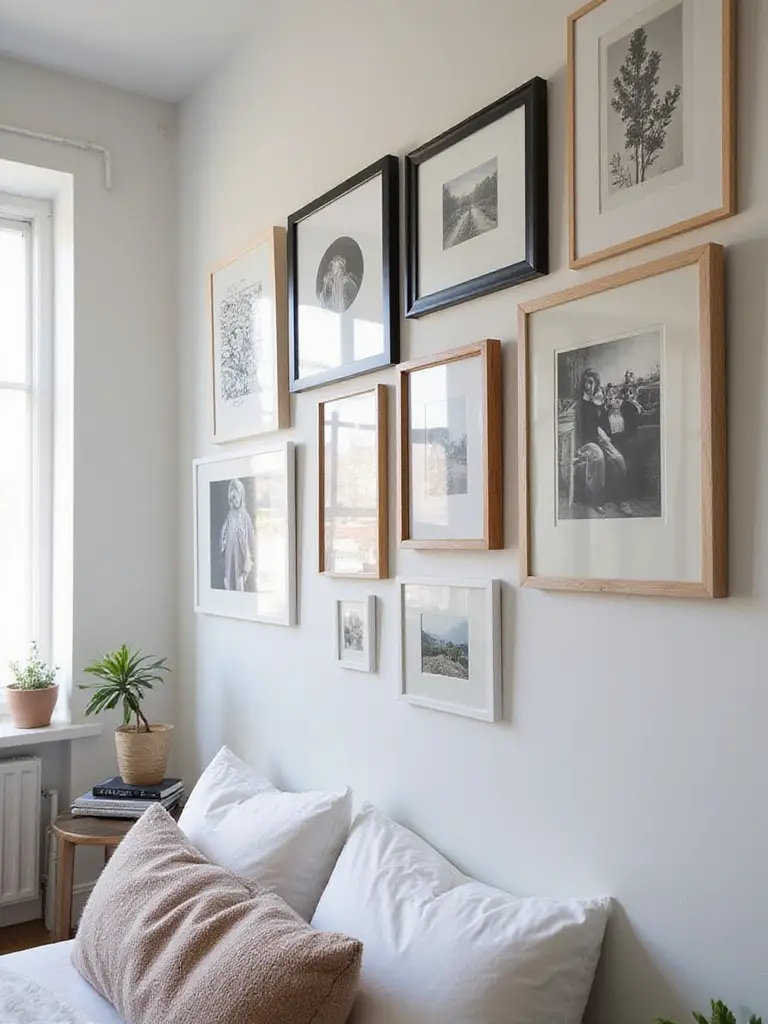
Creating paper templates of each frame and arranging them on the floor first allows you to experiment with different configurations. Once you’ve found the perfect arrangement, tape the templates to the wall and use them as guides for precise placement. This method eliminates guesswork and prevents multiple holes or adhesive marks from trial-and-error hanging.
Gallery wall planning steps:
- Arrange frames on the floor to test different configurations
- Create paper templates for precise wall placement
- Clean wall surfaces with rubbing alcohol before applying strips
- Follow manufacturer instructions for weight limits and application
The collaboration began with a conversation about making art accessible to renters who previously felt limited by traditional hanging methods.
13. Elevate Style with Thoughtfully Chosen Textiles and Linens
Thoughtfully chosen textiles transform apartment bedrooms through layered textures, colors, and patterns that create depth and visual interest without consuming floor space. Quality linens, throw pillows, and blankets can make a room feel 15-25% more expansive by adding dimension and softness. These elements allow for cost-effective style updates, enabling seasonal refreshes with 60-75% less investment than furniture changes.
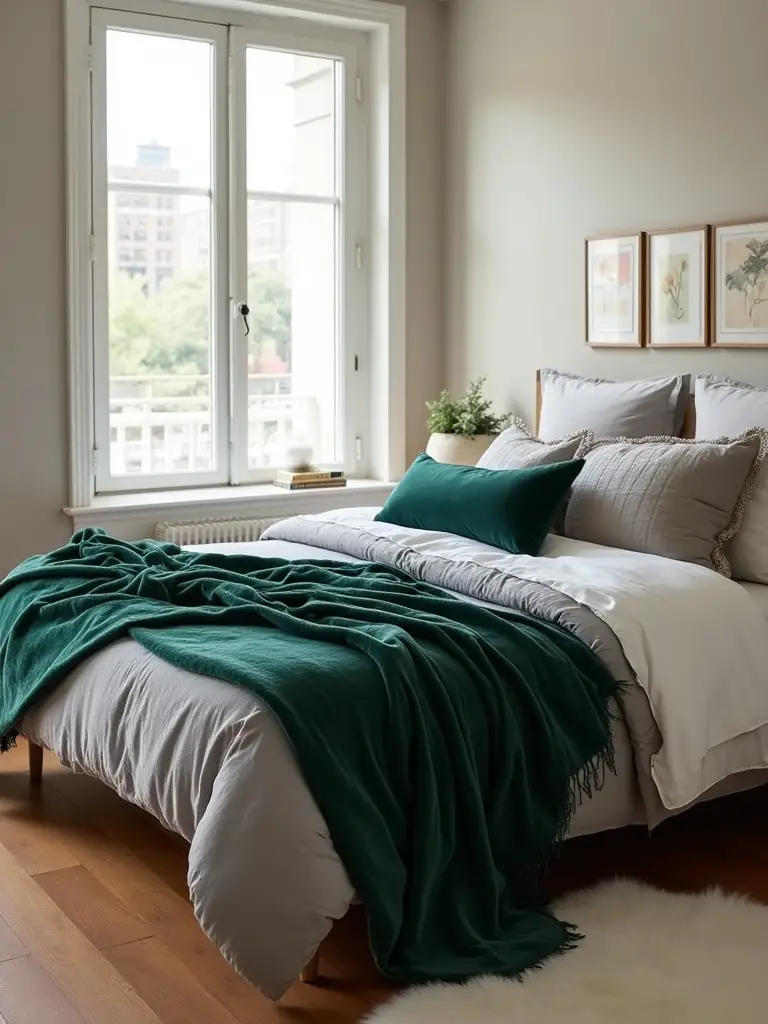
The key to successful textile layering lies in balancing different textures and scales. Combine smooth cotton sheets with chunky knit throws, or pair geometric patterns with organic textures. The 60-30-10 color rule applies beautifully to textiles: 60% neutral base colors, 30% secondary colors, and 10% accent colors for visual balance without overwhelming small spaces.
Textile layering strategies:
- Mix textures like linen, cotton, velvet, and knit for sensory richness
- Balance pattern scales to avoid visual chaos
- Choose breathable natural materials for comfort and durability
- Layer seasonal elements that can be easily swapped
The tactile experience changes the entire room’s energy when you select materials that invite touch and create a sense of luxury within practical constraints.
14. Install Blackout Curtains for Improved Sleep and Privacy
Blackout curtains serve dual purposes in apartment bedroom ideas, blocking external light for better sleep while providing privacy from nearby neighbors. These specialized window treatments can improve sleep quality by supporting natural melatonin production and maintaining consistent darkness for shift workers or those sensitive to light. Proper installation extends the curtain rod 4-6 inches beyond the window frame on all sides to minimize light leakage.
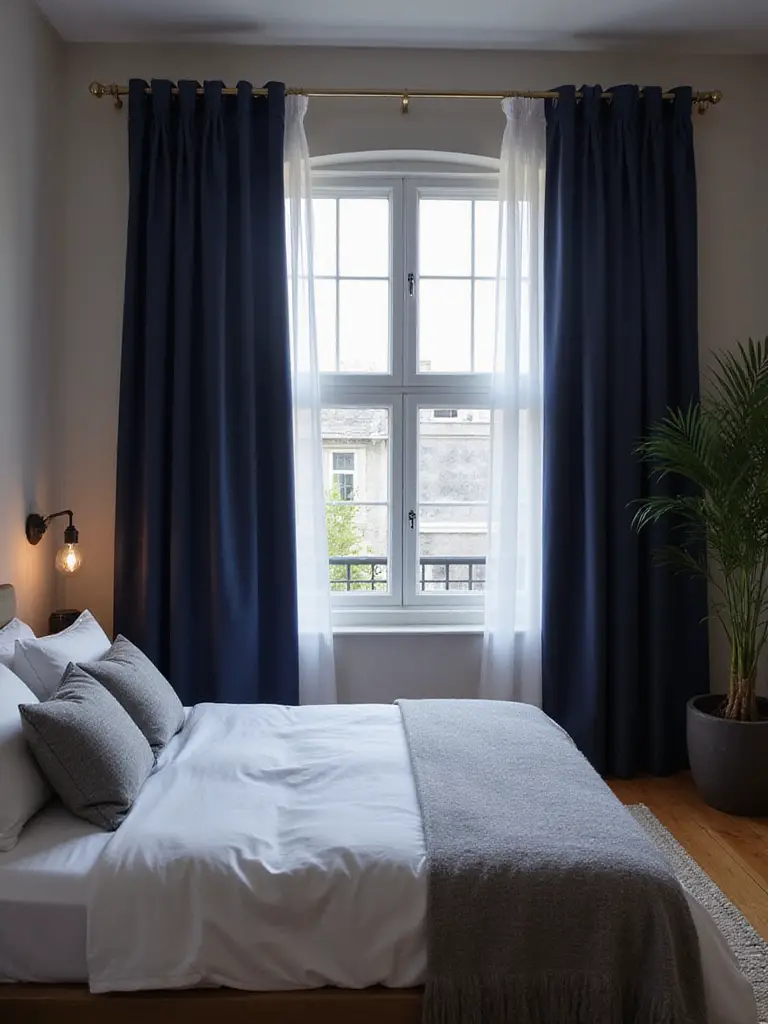
The energy efficiency benefits of blackout curtains often go unnoticed but can reduce heating and cooling costs by up to 25% through improved insulation. This thermal regulation proves particularly valuable in apartments where you may have limited control over building heating and cooling systems. Quality blackout curtains also provide sound dampening, reducing external noise that could disrupt sleep.
Blackout curtain installation tips:
- Extend rods beyond window frames to prevent light leakage
- Choose true blackout fabric rather than “room darkening” alternatives
- Consider layering with decorative sheers for daytime privacy
- Install close to the ceiling to maximize height illusion
The mood shifts dramatically when you add proper light control, transforming your bedroom into a restful sanctuary regardless of external conditions.
15. Create a Cozy Reading Nook with a Small Armchair
A dedicated reading nook transforms underutilized corners into purposeful, inviting spaces that increase the functional value of apartment bedrooms. This strategy effectively utilizes 5-10% more of your available square footage by converting dead space into a cherished personal retreat. The key lies in selecting appropriately scaled furniture and positioning it to take advantage of natural light without obstructing traffic flow.
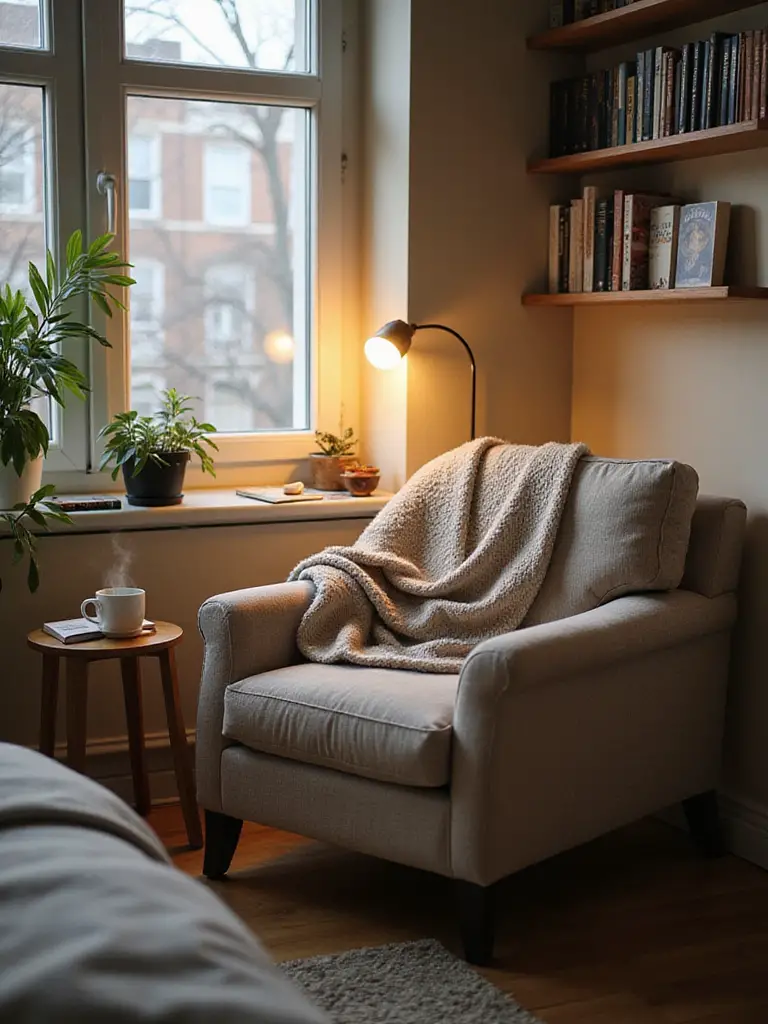
Compact armchairs or slipper chairs work best in small bedrooms, providing comfort without overwhelming the space. Add a small side table for books and beverages, along with appropriate task lighting for reading. A soft throw and decorative pillow complete the cozy atmosphere while maintaining the nook’s functionality for relaxation or quiet activities.
Reading nook essentials:
- Appropriately scaled seating that fits the available space
- Adequate task lighting positioned to avoid glare
- Small side table for books, drinks, and personal items
- Soft textiles for comfort and visual warmth
The finishing touch that elevates the entire look comes from treating this corner as a distinct zone with its own personality while maintaining harmony with the overall bedroom design.
16. Incorporate a Full-Length Mirror to Expand Visual Space
Full-length mirrors create powerful illusions of expanded space in apartment bedrooms, potentially making rooms feel up to 50% larger through strategic light reflection and visual depth. Proper placement opposite windows or perpendicular to light sources amplifies natural illumination while creating the impression of additional square footage. This dual functionality—practical dressing aid and space enhancer—makes mirrors essential elements in small bedroom design.
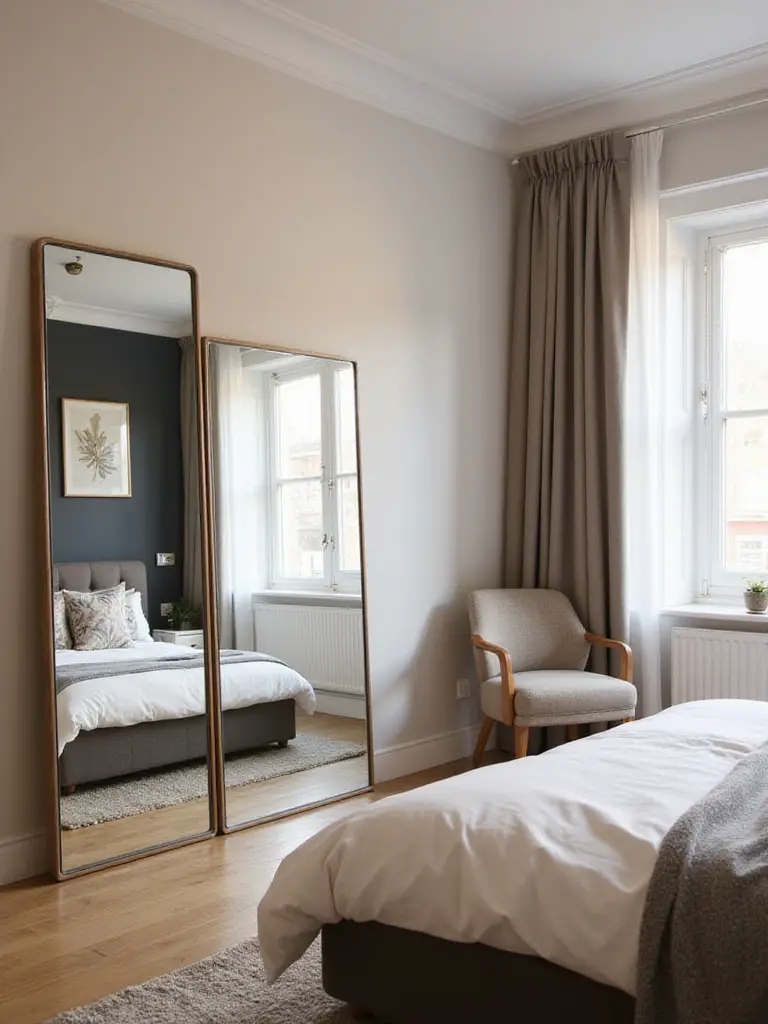
The positioning of your mirror significantly impacts its effectiveness. Avoid reflecting cluttered areas or undesirable views, which can negate the expansive effect. Instead, angle mirrors to reflect attractive elements like artwork, plants, or organized spaces. Leaning mirrors against walls can be just as effective as mounted ones while offering flexibility for future rearrangement.
Mirror placement strategies:
- Position to reflect natural light and attractive room elements
- Avoid reflecting cluttered or undesirable areas
- Consider size proportions relative to available wall space
- Ensure secure installation or stable leaning arrangement
The discovery of this technique happened when interior designers realized that mirrors don’t just reflect images—they reflect possibilities, making small spaces feel infinitely more open and bright.
17. Manage Cables with Discreet Cord Organizers
Cable management eliminates visual clutter that can make apartment bedrooms feel chaotic and disorganized. Tangled cords create an impression of messiness that undermines even the most thoughtful design efforts. Strategic cord organization can increase perceived room spaciousness by up to 15% while improving safety by reducing tripping hazards and preventing cable damage from kinks and tangles.
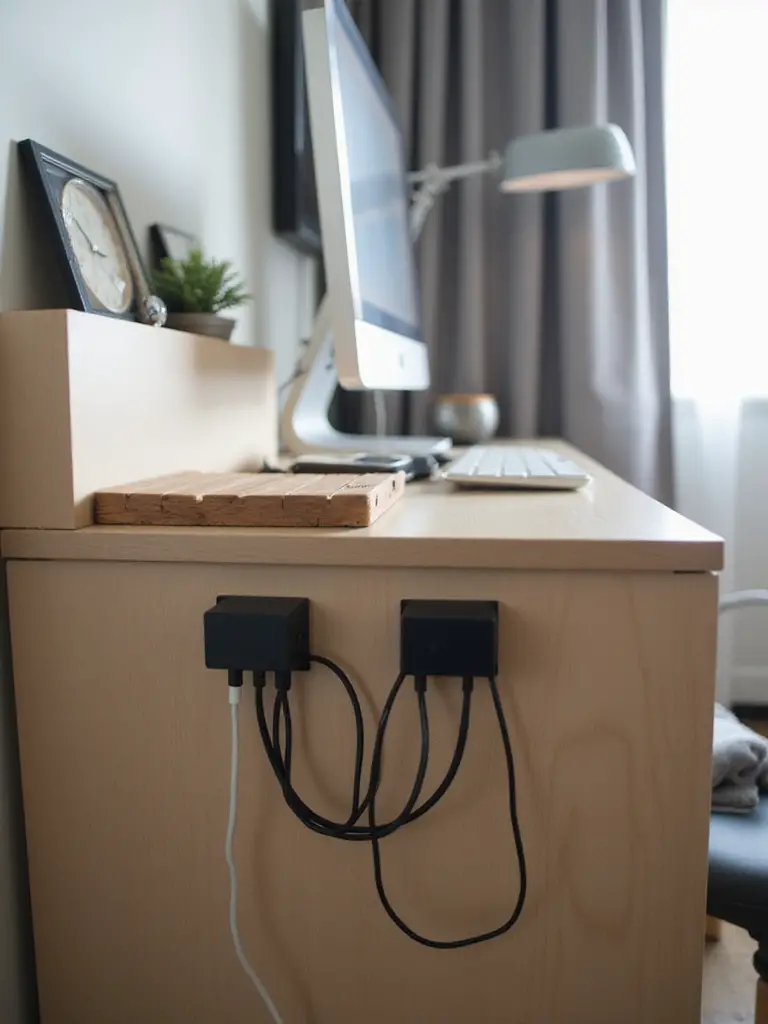
Effective cable management begins with assessment and decluttering—removing unnecessary cords and identifying the shortest routes for essential cables. Adhesive cable clips, cord sleeves, and management boxes provide discrete solutions for different situations. The goal is creating clean lines and clear surfaces that contribute to the overall sense of order and spaciousness.
Cable management solutions:
- Adhesive clips for routing single cables along furniture edges
- Cable sleeves for bundling multiple cords together
- Management boxes for hiding power strips and excess cable length
- Under-desk trays for keeping charging cables accessible but organized
The maker’s journey from apprentice to master influenced the development of these organizing systems, creating solutions that address both functionality and aesthetics.
18. Select a Calming Color Palette for Restful Sleep
Calming color palettes directly impact sleep quality and overall bedroom atmosphere, making color selection crucial among apartment bedroom ideas. Cool, muted tones like soft blues, greens, and grays have been scientifically linked to reduced heart rate and blood pressure, promoting faster sleep onset and deeper rest. Research shows that people with blue bedrooms sleep an average of 7 hours and 52 minutes—more than any other color.
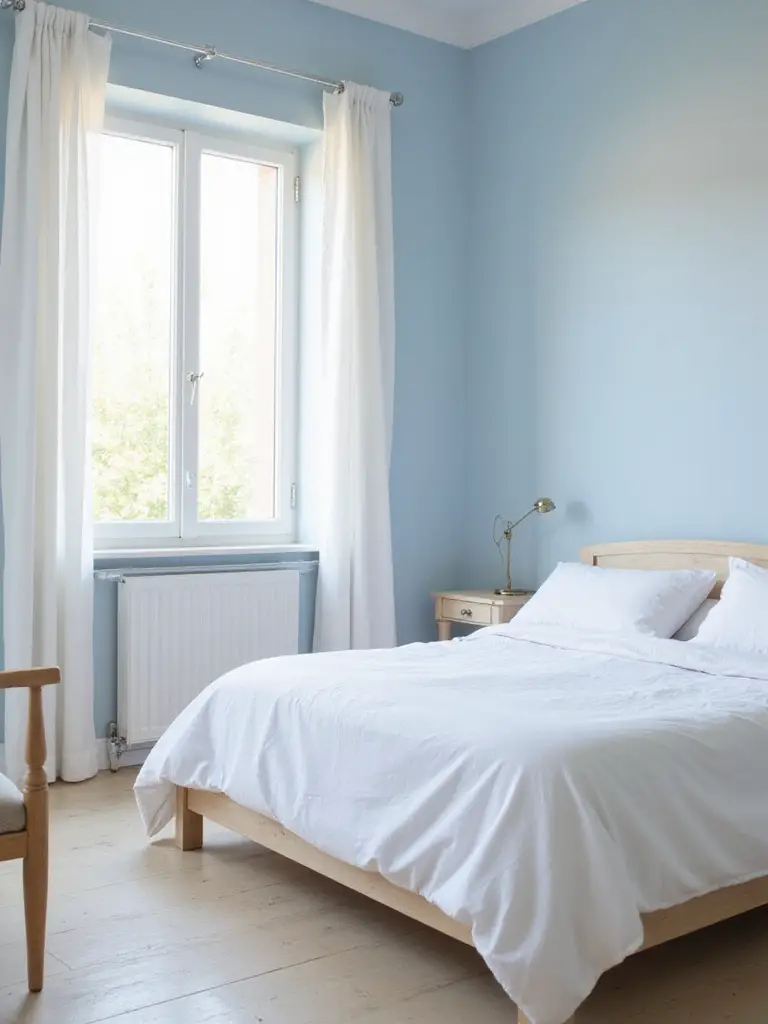
The 60-30-10 color rule provides a framework for balanced palette implementation: 60% dominant calming color for walls, 30% complementary secondary color for furniture and large textiles, and 10% accent color for smaller decorative elements. This approach creates visual harmony while preventing overwhelming stimulation that could interfere with relaxation and sleep.
Calming color palette guidelines:
- Choose cool, muted tones for primary wall colors
- Test colors under different lighting conditions before committing
- Extend the palette through bedding, curtains, and accessories
- Consider undertones to ensure cohesive color relationships
The emotional response this evokes begins with entering a space that immediately signals rest and tranquility, supporting your body’s natural transition to sleep.
19. DIY a Custom Headboard for Budget-Friendly Style
DIY headboards offer apartment dwellers complete creative control while achieving up to 70% cost savings compared to retail options. This approach allows for perfect customization to specific room dimensions, color schemes, and style preferences while often incorporating additional functionality like built-in storage or lighting. The key to success lies in careful planning and selecting appropriate materials for your skill level and design vision.

Upholstered headboards using plywood, batting, and fabric create luxurious looks for minimal investment. Reclaimed wood designs add character and warmth, while painted panels offer endless customization possibilities. Consider wall-mounted designs for maximum space efficiency and renter-friendliness, allowing for easy removal and minimal wall damage.
DIY headboard material options:
- Plywood and fabric for upholstered designs
- Reclaimed wood for rustic or industrial aesthetics
- MDF for painted or wallpapered surfaces
- Foam and batting for comfortable upholstered versions
The cultural heritage preserved in each piece includes the satisfaction of creating something uniquely yours while solving practical bedroom design challenges within budget constraints.
20. Soundproof Your Space with Acoustic Panels or Heavy Drapes
Soundproofing elements enhance apartment bedroom comfort by reducing external noise and improving internal acoustics. Heavy drapes can reduce window noise transmission by 5-10 decibels while acoustic panels decrease internal echo by 20-40%, creating a more peaceful environment for rest and relaxation. These solutions prove particularly valuable in urban apartments where noise pollution can significantly impact sleep quality.
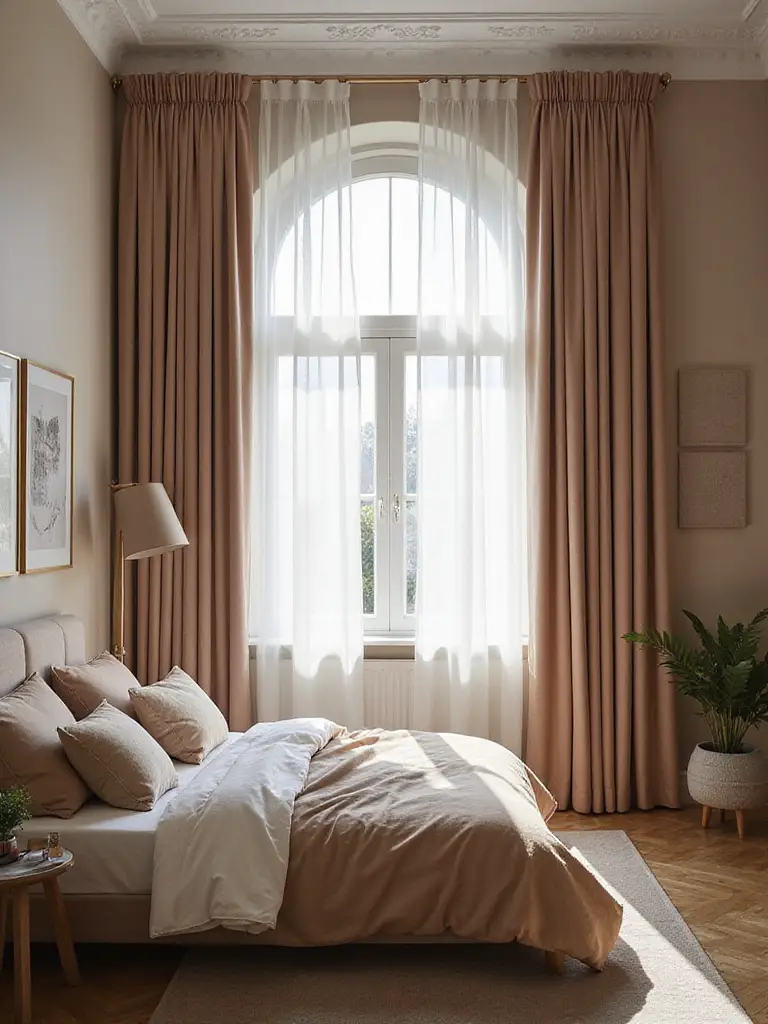
The effectiveness of soundproofing depends on proper material selection and installation. Heavy, multi-layered thermal curtains provide the best sound reduction for windows, while acoustic panels with high Noise Reduction Coefficients (NRC ratings of 0.60 or higher) work best for internal sound absorption. Strategic placement at first reflection points maximizes acoustic improvement.
Soundproofing implementation strategies:
- Install heavy drapes extending beyond window frames for maximum coverage
- Position acoustic panels at first reflection points on walls
- Seal gaps around doors and windows with weatherstripping
- Consider layered window treatments for dual functionality
The sustainable innovation narrative involves creating peaceful personal spaces within bustling urban environments, allowing for restorative rest regardless of external conditions.
21. Implement Smart Home Devices for Convenient Bedroom Control
Smart home devices represent the future of apartment bedroom ideas, offering convenient control over lighting, temperature, and ambiance through smartphone apps or voice commands. These technologies can reduce energy consumption by 10-15% through automated controls while improving sleep quality by up to 25% through customized environmental settings. The convenience factor alone makes daily routines more efficient and enjoyable.
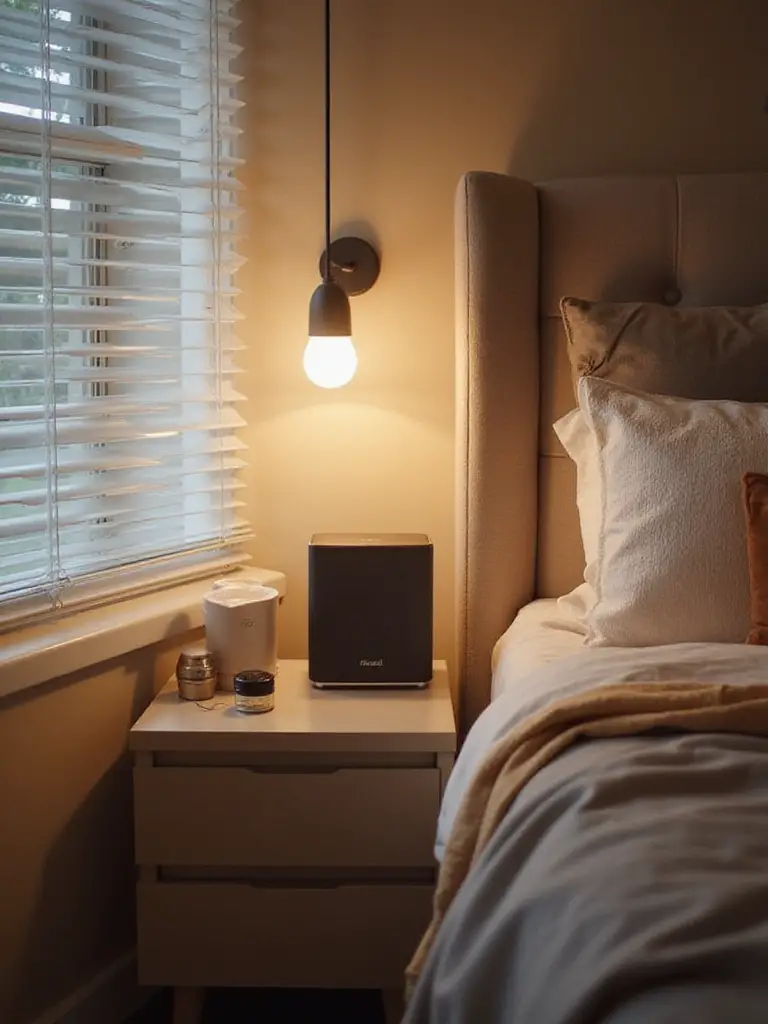
Starting with basic smart devices like bulbs, plugs, and a smart speaker provides immediate benefits without overwhelming complexity. Gradually expanding to include smart thermostats, automated blinds, or sleep tracking devices creates a comprehensive system that adapts to your lifestyle. The key is choosing compatible devices within a single ecosystem for seamless integration and control.
Essential smart home devices for bedrooms:
- Smart bulbs for customizable lighting and color temperature
- Smart plugs for controlling lamps and other devices remotely
- Smart speakers for voice control and audio entertainment
- Smart thermostats for optimal temperature regulation
The forecast for next season already hints at even more integrated solutions that will make apartment living more comfortable and efficient while maintaining the personal touch that makes a bedroom truly yours.
Conclusion
Creating an exceptional apartment bedroom requires more than just arranging furniture—it demands strategic thinking about how every element contributes to both function and style. These 21 apartment bedroom ideas demonstrate that small spaces aren’t limitations but opportunities for creative problem-solving. From maximizing vertical storage and choosing multi-functional furniture to implementing smart home technology and creating calming environments, each strategy addresses real challenges while enhancing your daily living experience.
The most successful apartment bedrooms combine practical solutions with personal style, creating spaces that feel both larger and more luxurious than their actual square footage. Whether you’re dealing with inadequate storage, poor lighting, or cramped quarters, these ideas provide proven methods for transformation. The key lies in starting with one or two changes that address your most pressing needs, then gradually building a comprehensive approach that maximizes both space and comfort.
Your apartment bedroom should be a sanctuary that supports your well-being while reflecting your personality. By implementing these apartment bedroom ideas thoughtfully and consistently, you’ll create a space that not only meets your practical needs but exceeds your expectations for style and comfort. The investment in smart design choices pays dividends in improved sleep, reduced stress, and enhanced daily routines that make apartment living truly enjoyable.
